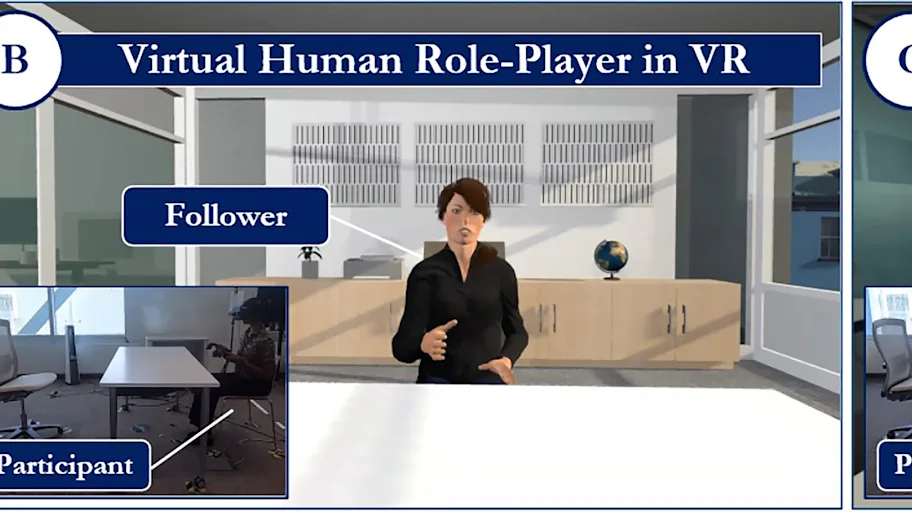
- Science news
- Health
- Virtual reality treatment for palliative care shown to help patients ‘flourish’ during relaxation therapy
Virtual reality treatment for palliative care shown to help patients ‘flourish’ during relaxation therapy

Patients in palliative care often receive psychological therapy to help cope with stress. Researchers have now shown that the short-term effectiveness of a novel intervention, Flourishing-Life-of-Wish Virtual Reality Relaxation Therapy, in improving the physical and emotional well-being of patients is double that of standard-of-care coaching in diaphragmatic breathing.
serious and often terminal illnesses. Its aim is to improve quality of life for such patients and their families, by relieving symptoms and stress. Palliative care is widely considered to be a human right, even if the World Health Organization estimates that only 14% of the approximately 56.8 million people who need it each year worldwide actually receive it. Since seriously ill patients often experience stress, psychological interventions such as relaxation therapy play an important role in palliative care.
Now, researchers have shown in a ground-breaking clinical trial that a novel intervention, Flourishing-Life-of-Wish Virtual Reality Relaxation Therapy (FLOW-VRT-Relaxation), helps cancer patients in palliative care hospices to manage their symptoms and stress better, and may even help them to achieve a last wish. Their results are published in Frontiers in Virtual Reality.
“Here we show that relaxation assisted by virtual reality (VR) outperforms traditional relaxation therapy in terms of physical and psychological symptom management in palliative care,” said lead author Olive Woo, a doctoral student at the Department of Psychology of the University of Hong Kong, and a registered clinical psychologist and certified thanatologist.
Virtual reality to induce ‘flourishing’
FLOW-VRT-Relaxation, designed by Woo and team in 2020, combines standard-of-care relaxation therapy – teaching patients diaphragmatic breathing, to slow their heartbeat, lower blood pressure, and reduce stress – with watching a relaxing 360° panoramic video played on an immersive VR headset. It aims to promote the psychological state of 'flourishing': optimal well-being and fulfillment, where patients experience positive emotions, engage in meaningful activities, and have a sense of purpose and accomplishment.
Between November 2022 and September 2023, the researchers recruited 128 volunteers among adult female and male patients with terminal cancer in the palliative care ward of a public hospital in Hong Kong. Half of the volunteers were randomly assigned to each of two groups: either FLOW-VRT-Relaxation, including coaching in diaphragmatic breathing by Woo, in the intervention group, or such standard-of-care coaching only in the control group.
Download original article (pdf)
The eight VR videos had been preselected (based on responses to a survey among eligible patients) as likely to give patients a sense of joy, closure, and a meaningful end-of-life experience. They may even help them to achieve a last wish, for example seeing the cherry blossoms in Japan, even if just in VR. Each video was 10 minutes long, and accompanied by soothing music. Similar music was also played for patients in the control group. Each participant in the intervention group chose his or her preferred video from the shortlist.
Spontaneous feedback from patients was positive: “Some participants expressed a sense of awe and wonder as they immerse themselves in virtual environments and engaged in activities they previously thought impossible. Others expressed feelings of joy, excitement, and gratitude for being able to fulfill their wishes or engage in activities they have always dreamed of, or a sense of empowerment and confidence through their engagement with VR technology,” observed Woo.
Physical and emotional benefits
The effectiveness of both treatment groups in promoting well-being was rated with the Cantonese version of the Edmonton Symptom Assessment System (CESAS): a questionnaire with known clinical validity that measures nine common symptoms of patients with cancer, such as pain, depression, and anxiety. A lower CESAS score means greater physical and emotional well-being.
CESAS scores dropped after treatment in both groups, but this improvement was significantly greater in the intervention group. For example, the score on the subscale for physical symptoms fell by 4.1 points (26.6%) in the FLOW-VRT-Relaxation group, compared to 2.1 points (13.0%) in the control arm, while the score on the subscale for emotional symptoms by 2.25 points (47.4%) in the FLOW-VRT-Relaxation arm, compared to 1.0 points (19.6%) in the control group.
The authors conclude that FLOW-VRT-Relaxation is an effective, inexpensive, scalable, and personalized therapy for patients in palliative care, at least in the short term.
“We believe that the VR experiences activate psychological mechanisms that promote self-determination, flow experience, and restoration, ultimately improving the physical and emotional well-being of patients in palliative care more than does relaxation therapy alone,” said co-author Dr Antoinette Lee, a health psychologist at the same institute as Woo and her academic supervisor.
Further research planned
The researchers plan to follow up the present study by studying the longer-term effects of FLOW-VRT-Relaxation on patients’ well-being.
“Our present study was the first of its kind to rigorously test the efficacy of VR-assisted relaxation among patients under palliative care in a randomized controlled trial with an adequate sample size,” said co-author Dr Alvaro Cassinelli, an associate professor with expertise in augmented and virtual reality.
“We look forward to investigating further the advancement of personalized virtual reality and augmented reality environments currently explored in the framework of doctoral work by co-authors Royce Ng and Daniel Eckhoff.”
REPUBLISHING GUIDELINES: Open access and sharing research is part of Frontiers’ mission. Unless otherwise noted, you can republish articles posted in the Frontiers news site — as long as you include a link back to the original research. Selling the articles is not allowed.






